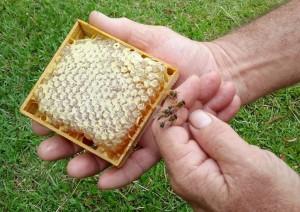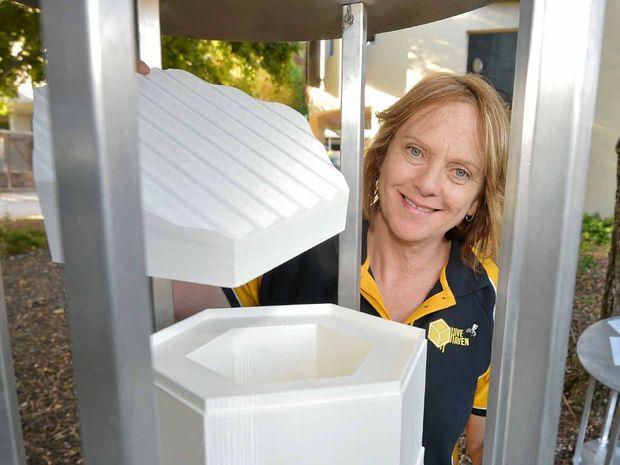 For some reason, bees come up a lot in 3D printing. If you think about it, bees are kind of like tiny living 3D printers – in fact, some strange ideas about genetically modifying bees to act as actual 3D printers have already been presented. But we’ve also seen several cases of people using 3D printing to help bees, which, sadly, need a lot of help right now. Recently, New Zealand researchers developed a technique of 3D printing honeycombs to help bees with their workload, and now some Australian beekeepers are going a step further with their plan to 3D print entire beehives.
For some reason, bees come up a lot in 3D printing. If you think about it, bees are kind of like tiny living 3D printers – in fact, some strange ideas about genetically modifying bees to act as actual 3D printers have already been presented. But we’ve also seen several cases of people using 3D printing to help bees, which, sadly, need a lot of help right now. Recently, New Zealand researchers developed a technique of 3D printing honeycombs to help bees with their workload, and now some Australian beekeepers are going a step further with their plan to 3D print entire beehives.
 HiveHaven is a Sunshine Coast startup that builds bee boxes for honeybees and stingless bees, a harmless relative of the honeybee that is equally crucial to pollination and therefore global food supply. They’re also equally threatened – perhaps even more so, as the native Australian stingless bee cannot regulate its temperature the way honeybees can. According to Ann Ross, co-founder of HiveHaven, stingless bees start dying off when temperatures get to about 40 degrees Celsius.
HiveHaven is a Sunshine Coast startup that builds bee boxes for honeybees and stingless bees, a harmless relative of the honeybee that is equally crucial to pollination and therefore global food supply. They’re also equally threatened – perhaps even more so, as the native Australian stingless bee cannot regulate its temperature the way honeybees can. According to Ann Ross, co-founder of HiveHaven, stingless bees start dying off when temperatures get to about 40 degrees Celsius.
To combat this threat, Ross and others at HiveHaven are trying to build 3D printed beehives that can regulate their own temperature – and do a lot more. Without human interference, nature has a pretty good system for keeping itself healthy, balanced and regulated. Unfortunately, humans have interfered quite a bit with nature, causing everything to get out of whack. Climate change, pesticides, habitat alteration and more have made the global bee population very vulnerable. Thankfully, there are humans like Ann Ross and her husband and co-founder Jeff, who are using some of our most advanced technologies to bring back some of the balance we have upset.“Compare the stingless native bee to a honeybee, which collects water on a hot day and fans the hive — as a sort of evaporative cooler — the stingless native bee doesn’t have the ability to do that, and are very susceptible to heat,” Ross said.
 Traditionally, beekeepers have used boxes made from old growth hoop pine, but the material has become unsustainable, so the Rosses developed a method of building bee boxes from HDPE, which is derived from recycled plastic bottles. The plastic boxes are durable and provide protection from diseases and pests. They require little maintenance, are easily washed and sanitized, and HiveHaven even offers built-in GPS and Radio Frequency Identification technology.
Traditionally, beekeepers have used boxes made from old growth hoop pine, but the material has become unsustainable, so the Rosses developed a method of building bee boxes from HDPE, which is derived from recycled plastic bottles. The plastic boxes are durable and provide protection from diseases and pests. They require little maintenance, are easily washed and sanitized, and HiveHaven even offers built-in GPS and Radio Frequency Identification technology.
HiveHaven manufactures two varieties of the boxes to address the different needs of honeybees and stingless bees. Currently, Jeff Ross is milling them by hand, but the process takes a lot of time, so the Rosses are hoping to begin 3D printing the boxes so that they can mass-produce them. According to Ann Ross, 3D printed material also offers more effective insulation and protection from spore-based disease.
 Unfortunately, 3D printing a bee box costs around $900, whereas a traditional pine box costs about $100. Last year, HiveHaven ran an Indiegogo campaign to try to raise enough money to start 3D printing, but the campaign fell short of its funding goals. The Rosses weren’t discouraged; the money they did raise gave a big boost to their company, but for now they have put 3D printing on hold. It’s still a goal for the future, though, and the company has been successful in spreading their bee boxes around Queensland. The boxes are in place at several trial locations along the Sunshine Coast, and the Queensland Beekeepers Association has been successfully using them for over a year.
Unfortunately, 3D printing a bee box costs around $900, whereas a traditional pine box costs about $100. Last year, HiveHaven ran an Indiegogo campaign to try to raise enough money to start 3D printing, but the campaign fell short of its funding goals. The Rosses weren’t discouraged; the money they did raise gave a big boost to their company, but for now they have put 3D printing on hold. It’s still a goal for the future, though, and the company has been successful in spreading their bee boxes around Queensland. The boxes are in place at several trial locations along the Sunshine Coast, and the Queensland Beekeepers Association has been successfully using them for over a year.
Right now, HiveHaven is seeking corporate sponsorship to help further their research. They can be contacted at hello@hivehaven.com.au, or you can reach them on Facebook. You can see their original crowdfunding pitch below. Tell us what you think of this concept in the HiveHaven 3D Printed Bee Boxes forum on 3DPB.com.
https://youtu.be/fwKWLWQXGvM
[Images: HiveHaven, via Facebook]
Subscribe to Our Email Newsletter
Stay up-to-date on all the latest news from the 3D printing industry and receive information and offers from third party vendors.
You May Also Like
Printing Money Episode 17: Recent 3D Printing Deals, with Alex Kingsbury
Printing Money is back with Episode 17! Our host, NewCap Partners‘ Danny Piper, is joined by Alex Kingsbury for this episode, so you can prepare yourself for smart coverage laced...
Insights from Cantor Fitzgerald on AM’s Q1 2024 Landscape
A recent survey by Cantor Fitzgerald sheds light on the persistent challenges within the additive manufacturing (AM) industry in the first quarter of 2024. Based on responses from 38 industry...
3D Printing Financials: Xometry’s Scaling up and Strong Start to 2024
Xometry (Nasdaq: XMTR) kicked off 2024 with strong results, boosting its marketplace and technology to new heights. Both revenue and gross margin soared, fueled by an expanding global network of...
3D Printing Financials: Desktop Metal Targets Recovery Amid Net Losses and Revenue Downturn
Despite facing a decline in revenue and the persistent challenges of a tight economic climate, Desktop Metal (NYSE: DM) is making strides toward operational efficiency. The first quarter of 2024...

































